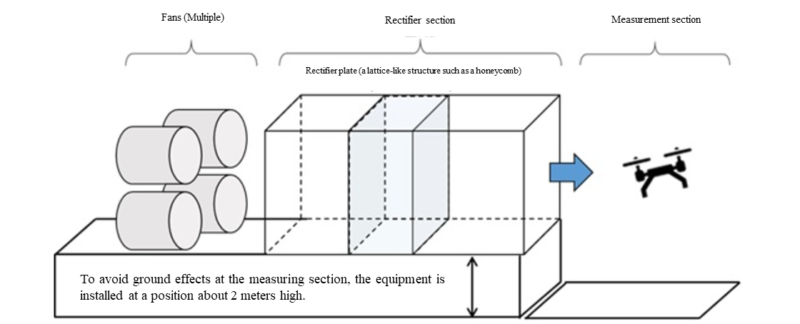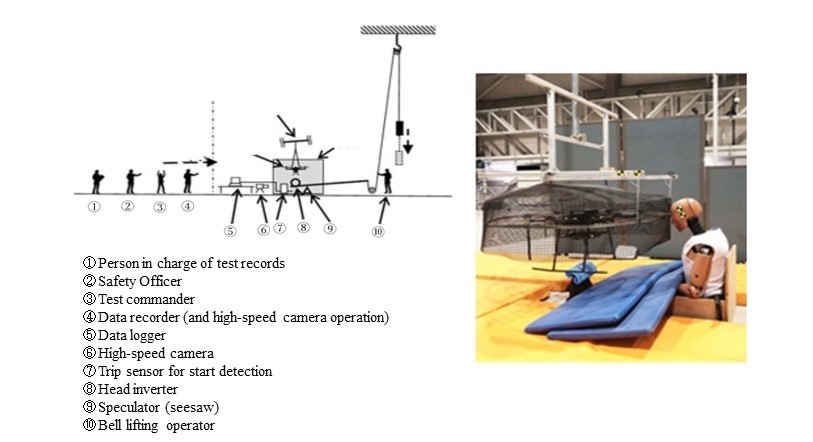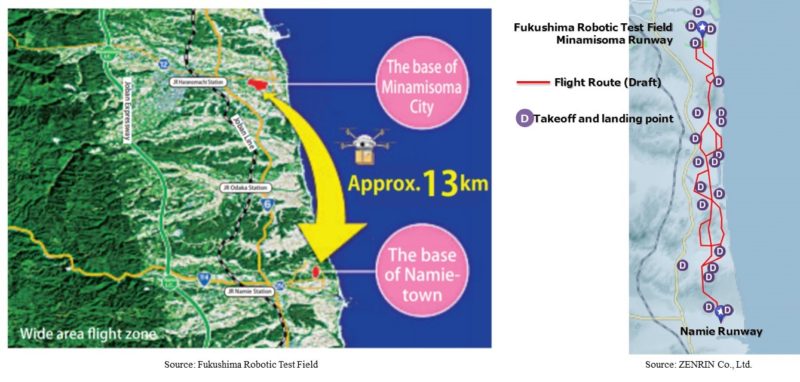- HOME
- NEWS RELEASE
- Publication of Performance Evaluation Procedure for Unmanned Aircraft Flies over People - Available for testing in the Fukushima Robotic Test Field -
Publication of Performance Evaluation Procedure for Unmanned Aircraft Flies over People - Available for testing in the Fukushima Robotic Test Field -
NEDO and Ministry of Economy, Trade and Industry (METI) have released the “Performance Evaluation Procedure for Unmanned Aircraft Flies over People” to ensure safe Beyond Visual Line of Sight (BVLOS) flight of unmanned aircraft over people.
It is necessary to meet various performance requirements, such as safety and environment, to operate an unmanned aircraft BVLOS and over people. This procedure provides performance evaluation standards for safety and reliability, and summarizes test methods, test facilities, and equipment in order to fly an unmanned aircraft BVLOS and over people. This is the first performance evaluation procedure in Japan. This procedure enables the unified performance evaluation of unmanned aircraft, establishment of performance goals, and development of guideline for the operation of unmanned aircraft. The Fukushima Robot Test Field, which was fully opened in March 2020, has a relevant test facility in place and can be used to conduct evaluation tests based on this procedure.
In the near future, we will work to disseminate this procedure and accelerate the use of unmanned aircraft in the fields of logistics, disaster response, and other areas.
 Unmanned aircraft used in the test
Unmanned aircraft used in the test
1.Overview
In recent years, the use of unmanned aircraft and robotics is expected to realize energy savings in the field of logistics and disaster response, where efficient energy use is required because of increasing small-lot transportation and decreasing loading ratio. The Roadmap for the Industrial Revolution of the Airspace 2019, revised in June 2019, defines flight levels 1 to 4 according to the area and method of flight. The roadmap expect BVLOS flight (Level 3) in unmanned areas and BVLOS flight over people (Level 4) after FY2022. To realize this, the Ministry of Land, Infrastructure, Transport and Tourism (MLIT) and METI jointly held "Review conference for BVLOS flight over people by unmanned aircraft", and published the "Requirements on BVLOS flight by unmanned aircraft (LEVEL 3)" in March 2018. In response to this trend, stakeholders need to examine the requirements for realizing BVLOS flight over people in the future.
Under this background, NEDO is conducting research and development for evaluating the airframe's performance in terms of flight stability, guidance accuracy, and reducing harm to the ground.Based on flight test data collected in the Fukushima Robotic Test Field, the authors consulted the Unmanned Aircraft Performance Evaluation Standards Review Committee to confirm the validity of these performance evaluation standards and test methods. As a result, the METI and NEDO released "Performance Evaluation Procedure for Unmanned Aircraft Flies over People".
This procedure provides performance evaluation standards for safety and reliability, and summarizes test methods, test facilities, and equipment in order to fly an unmanned aircraft BVLOS and over people. This is the first performance evaluation procedure in Japan. This procedure enables the unified performance evaluation of unmanned aircraft, establishment of performance goals, and development of guideline for the operation of unmanned aircraft.
This procedure was developed as part of a collaboration agreement between NEDO and Fukushima prefecture in November 22, 2017 on demonstration of robotics and drones. The Fukushima Robots Test Field, which fully opened in March 2020, has been equipped with relevant test facilities usable for evaluation tests based on this procedure.
2.Detail of the Performance Evaluation Procedure
The procedure consists of three editions, "VLOS and BVLOS Edition", "Flight over People Edition" and "Long-Distance Flight Edition", which quoted relevant parts to long-distance flight from first two editions because the flight is expected to increase with the deployment of Level 3 and Level 4 in the future.
(1) VLOS and BVLOS Flight Edition
This edition prescribes evaluation standards and evaluation procedures of performance evaluation items composed of common, logistics specific, and disaster investigation specific categories.
 List of Performance Evaluation Items (VLOS and BVLOS Flight Edition)
List of Performance Evaluation Items (VLOS and BVLOS Flight Edition)
 Examples of tests described in the Procedure (Wind Resistance, Wind Tunnel Equipment)
Examples of tests described in the Procedure (Wind Resistance, Wind Tunnel Equipment)
(2) Flight over People Edition
This edition provides performance evaluation standards and performance evaluation procedures about items related to flight over people.
 Performance Evaluation Items (Flight over people)
Performance Evaluation Items (Flight over people)
 Example of the test described in the procedure (interpersonal collision: conceptual diagram (left) and test photo (right))
Example of the test described in the procedure (interpersonal collision: conceptual diagram (left) and test photo (right))
(3) Long-Distance Flight Edition
Regarding performance items related to long-distance flight, we have established a procedure for evaluating the performance of unmanned aircraft that can be used for verification in long-distance flights between the Minami-Soma runway and Namie runway in the Fukushima Robotic Test Field. For performance evaluation standards for each performance item, test methods, test facilities, and devices, see (1) and (2).
 Long Distance Flight Image (Left) and Long Distance Flight Route (Right) between Minami Soma Runway and Namie Runway
Long Distance Flight Image (Left) and Long Distance Flight Route (Right) between Minami Soma Runway and Namie Runway(Even when flying this route, the rules of the Aviation Act apply. For details such as adjustment for long distance flight in this area, contact the Fukushima Robotic Test Field.)
You can download the performance evaluation procedures described in (1) to (3) above from the website of METI (Only in Japanese).
Performance Evaluation Procedure (METI)
3.Next Action
NEDO continues working with METI to promote the use of the Fukushima Robot Test Field, and contributing to accelerating the use of unmanned aircraft in the fields of logistics, disaster response, and other areas.

